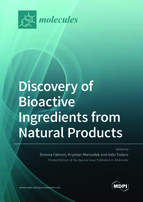Discovery of Bioactive Ingredients from Natural Products
A special issue of Molecules (ISSN 1420-3049). This special issue belongs to the section "Natural Products Chemistry".
Deadline for manuscript submissions: closed (15 March 2021) | Viewed by 71092
Special Issue Editors
Interests: citrus bioactive compounds; recovery of high value compounds from fruit processing wastes; mild food processing; quality of foods; traceability of organic food productions
Special Issues, Collections and Topics in MDPI journals
Interests: fruits; vegetables; emerging techniques; food processing and preservation; bioaccessibility and bioavailability; high-pressure processing; high-pressure homogenization; high-pressure carbon dioxide; ultrasounds; microwaves; food chemistry
Special Issues, Collections and Topics in MDPI journals
Interests: fruit quality; horticultural physiology and preservation recovery of high value compounds from food processing wastes; fruit processing
Special Issues, Collections and Topics in MDPI journals
Special Issue Information
Dear Colleagues,
The Mediterranean diet is worldwide recognized as associated to a lower risk of cancer, heart disease and stroke. This lower risk is universally ascribed to the high intake of vegetables and fruits, thus producing an high ingestion of phytochemicals. At present there is a great interest in the development of new nutraceuticals of natural origin to be employed within the pharmaceutical field and/or as dietary supplements. For instance, agri-food industry produces a large amount of wastes which can be conveniently used for the recovery of valuable health-promoting compounds to be used as natural ingredients.
Therefore, this Special Issue of Molecules is dedicated to original research and review articles that cover the latest findings about new extraction techniques for the recovery of bioactive constituents from fruit and/or vegetables, chemical characterization of phytoextracts with valuable biological activity, in-vivo tests and in-vitro bioassays to support biological activity of purified compounds, complex extracts and /or combined extracts deriving from different matrices. Studies aimed at the valorization of bioactive extracts deriving from traditional or ancient plant and/or fruit species are also welcome.
You may choose our Joint Special Issue in Chemistry.
Dr. Simona Fabroni
Prof. Krystian Marszałek
Prof. Aldo Todaro
Guest Editors
Manuscript Submission Information
Manuscripts should be submitted online at www.mdpi.com by registering and logging in to this website. Once you are registered, click here to go to the submission form. Manuscripts can be submitted until the deadline. All submissions that pass pre-check are peer-reviewed. Accepted papers will be published continuously in the journal (as soon as accepted) and will be listed together on the special issue website. Research articles, review articles as well as short communications are invited. For planned papers, a title and short abstract (about 100 words) can be sent to the Editorial Office for announcement on this website.
Submitted manuscripts should not have been published previously, nor be under consideration for publication elsewhere (except conference proceedings papers). All manuscripts are thoroughly refereed through a single-blind peer-review process. A guide for authors and other relevant information for submission of manuscripts is available on the Instructions for Authors page. Molecules is an international peer-reviewed open access semimonthly journal published by MDPI.
Please visit the Instructions for Authors page before submitting a manuscript. The Article Processing Charge (APC) for publication in this open access journal is 2700 CHF (Swiss Francs). Submitted papers should be well formatted and use good English. Authors may use MDPI's English editing service prior to publication or during author revisions.
Keywords
- bioactive constituents
- phytoextract
- biological activity
- natural products
- natural compounds
- marine compounds
- herbals
- phytochemicals
Related Special Issues
- Discovery of Bioactive Ingredients from Natural Products in Chemistry (3 articles)
- Discovery of Bioactive Ingredients from Natural Products II in Molecules (36 articles)
- Discovery of Bioactive Ingredients from Natural Products III in Molecules (16 articles)
- Discovery of Bioactive Ingredients from Natural Products IV in Molecules (11 articles)
- Discovery of Bioactive Ingredients from Natural Products V in Molecules









